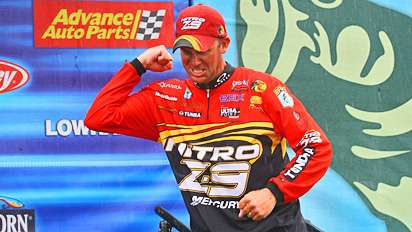
Continued from Page 1
VanDam targeted main lake points and secondary points, where bass were holding and only occasionally going into feeding frenzies on schools of large gizzard shad.”I cranked that bait real fast,” he said. “I was just trying to find a point that had a little irregularity on it, a little flat spot or something that was different than anything else in that area.”
Rocks, brush piles and, when the lake is high, flooded willow trees are the main fish holding structures in Grand Lake. Mike McClelland won this tournament last year, when the lake was lower, by concentrating on brush piles.
There was no doubt VanDam was focused on rocks this week. He averaged boating about six rocks per day, some that pulled as hard as a four-pound bass.”The rocks are real porous here, so they tend to hang on to a crankbait,” VanDam said.Rocks are at times important for attracting gizzard shad, according to Gene Gilliland, senior fisheries biologist for the Oklahoma Department of Wildlife. Gizzard shad feed mainly on plankton.
“They also eat the benthic goop on the bottom of the lake,” Gilliland said. “You’ll see them grazing on rocks at times.”
Gilliland said bright sunlight tends to concentrate schools of gizzard shad. The shad disperse at night, so low light conditions tend to spread them out more.It was Saturday’s mostly overcast, often rainy skies that caused VanDam’s only hiccup. His limit weighed “only” 16-8 that day. Although Sunday’s weigh-in was drenched by a heavy thunderstorm, the anglers fished under mostly sunny skies that day.
VanDam pulled his crankbaits mainly through water depths of 4 to 15 feet. The two different crankbait models and the two different strength lines allowed him to bang the rocks at all depths within his target range.
“The Series 5 is a little bit smaller bait,” VanDam said. “It runs up to about 10 feet deep, depending on what size line you use. The Series 6 will run up to about 15 feet deep.”Heavier strength and, therefore, thicker line makes a crankbait run shallower than lighter strength, thinner line. On the shallower-running Series 5, VanDam would cast it on 17-pound fluorocarbon line in 4- to 7-foot depths. Then he’d pick up a rod that had 12-pound line on the reel and a Series 5 tied on the line when he wanted to probe rocks 7 to 10 feet deep. He used that same set up on the Series 6 deeper-running lure to more effectively work those 10- to 15-foot depths — 17-pound test for depths of 10 to 13 feet; 12-pound test for depths of 13 to 15 feet deep.Another critical part of VanDam’s arsenal was the hooks on his crankbaits. You want sharp hooks in any fishing situation, and it’s difficult for them to remain sharp when you’re banging them off and, sometimes, into rocks.”I probably changed 50 hooks on my crankbaits this week,” VanDam said. “I’m using a new Mustad hook. It’s really heavy duty, almost a saltwater hook. It’s real stiff. The bigger diameter wire seemed to hold the fish a lot better.”It was one of the keys. I had a lot of fish that were barely hooked. When the hooks would get dinged up and dulled from the rocks, I’d just put another (treble hook) on there.
One other key weapon, according to VanDam, was a Biosonix Fish Activator with BSX sound technology. Through a patented underwater speaker, this equipment claims to put out sound vibrations mimicking distressed baitfish and live bait being attacked by predator fish, like largemouth bass feeding on gizzard shad.VanDam’s been using this for awhile. He credits it for helping him win the 2005 Bassmaster Classic.”I kept my Biosonix on a real active shad pattern,” said VanDam of his technique at Grand Lake. “Basically, what it does is help bring the shad up. And when bass hear that sound of other bass eating shad, I think they get more aggressive.
“There was one time during the first day of the tournament, I sat there and caught fish on every cast for about 40 minutes. You can’t do that unless you can keep them active. I’m convinced Biosonix is one of the key things that does that.”But VanDam’s main weapon is always his level of activity. No one makes more casts than VanDam during a day of tournament fishing, especially when he’s on a strong crankbait bite like he was at Grand Lake.
“If I caught a bass or two, then I’d really work that area thoroughly,” he said. “A lot of times I’d sit there and make the same cast 30 or 40 times, then bam, catch one. You had to make these fish react.”And as he proved again last week, nobody can make fish react like three-time BASS Angler of the Year Kevin VanDam.
